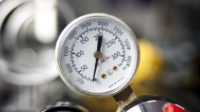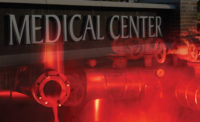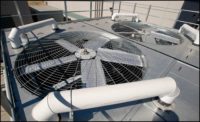At large institutional facilities and educational campuses, particularly those located in colder climates, steam flow measurement is a critical challenge. Facility operators want to accurately track steam usage as part of a wider effort to improve distributed/district heating resource management and energy conservation. However, traditional steam metering technologies have numerous performance drawbacks.
Rising costs and green energy initiatives are driving facility engineers to seek new solutions for accurately measuring steam consumption within HVAC systems. In particular, advancements in differential pressure (DP) flow meter technology make it possible to achieve significant improvements in energy management programs.
Background
With energy costs continuing to rise every year, it’s more important than ever to make sure that HVAC applications are running as efficiently as possible — with a clear understanding of exactly where and when energy is being used. After all, the system that works so hard to keep a building comfortable accounts for a large percentage of its total energy consumption.
Many institutional and educational campuses are served by distributed steam heating systems supplied from a central boiler plant. Steam energy generated from boilers is moved downstream in pipelines and then distributed to different areas of the facility. Adequate steam capacity is provided by maintaining distribution pressures. Generally, distribution lines are sized to provide adequate steam at system peak conditions. During most of the heating year the system demand is much less than peak. When the steam demand is down, reduced steam pressure may still supply the required heat. Reducing the system operating pressure saves energy by reducing transmission heat loss from distribution surfaces and minimizing the loss from steam leaks.
At many campus complexes, central plant engineers are unaware of how much steam energy they actually use due to a lack of necessary instrumentation to measure energy distribution and consumption. This situation reduces efficiency, increases costs, and adds to the load on costly equipment assets.
Need to Measure Flow
For managers of large institutional and educational sites, accurate measurements of steam output and distribution allow them to sub-allocate steam usage and report it directly to the central plant for increased energy efficiency. Additionally, precise flow monitoring improves process quality, optimizes accountability, and reduces downtime.
Facility managers oftentimes estimate steam flow either by measuring condensate or determining the total output of steam generated and distributed to each building. Increasingly, they are seeking an effective steam flow metering system to:
- Evaluate ongoing energy consumption to establish benchmarks;
- Verify the efficiency of steam utilization;
- Set targets for areas of the facility with high steam consumption;
- Implement preventive maintenance for system assets; and
- Provide guidance for future energy management decisions.
Steam is the most difficult fluid to measure when compared to liquids, gases, and air. It is very easily influenced by changes in temperature and pressure, and to that extent can be considered an unstable fluid. Condensation and heat present additional problems for steam flow measurement devices.
Most steam flow meters measure a velocity or volumetric flow of the steam and, unless this is done carefully, the physical properties of steam will impair the ability to measure and define a mass flow rate accurately.
When it comes to obtaining measurements of steam flow within an HVAC system, it is often necessary to install metering equipment in areas of buildings where the space for piping is extremely limited. This causes a problem since flow meters typically require significant runs of straight pipe upstream and downstream of the installation to work correctly.
Facility operators also suffer financial consequences for generating steam that passes through a flow meter but fails to get measured. These steam losses, known as low-flow cutoff, are associated with the turndown ratio of certain meter designs.
Understanding DP Technology
Steam flow measurement is a critical aspect of many large facility operations, and users choosing equipment to meter steam flow in HVAC applications must consider a wide range of factors to arrive at an optimal solution.
With ever-increasing demands on steam producers and users to increase revenues, reduce costs, and minimize waste, traditional flow meter technologies sometimes struggle to meet the challenge.
Experience has shown that institutional facilities can improve their steam resource utilization by installing DP flow meters. DP meters are versatile instruments, which employ a proven, well-understood measuring technology that does not require moving parts in the flow stream. The meters are not greatly affected by viscosity changes.
Differential pressure flow meters use Bernoulli’s equation to measure the flow of fluid in a pipe. They introduce a constriction in the pipe that creates a pressure drop across the flow meter. When the flow increases, more pressure drop is created. Impulse piping routes the upstream and downstream pressures of the flowmeter to the transmitter that measures the differential pressure to determine the fluid flow.
Among the available styles of DP flow meters, an orifice plate is the most common, but flow nozzles, averaging pitot tubes, wedge meters, venturis, and many others can be used. It is even possible to measure the differential pressure across the inside and outside of an elbow to determine flow rate.
Latest Design Advancements
Recent advancements in differential pressure flow meter technology have resulted in devices employing a specialized “cone” configuration. These meters provide highly accurate and repeatable measurements of liquids, gases, and steam. Their design enables longer lasting accuracy and lower permanent pressure loss than other meters, reducing maintenance and operating costs.
An examination of the basic cone meter configuration shows that it is simply an inverse venturi. The beta ratio (the ratio of area between the differing diameters) controls the amount of differential pressure generated for a given flow rate, just like most other head-producing devices. The major difference is that the cone interacts with the core velocity first and then re-proportions the flow around the cone.
Cone-style flow meters are resistant to the effects of asymmetric and swirling flow and can be built to meet the highest pressure and temperature specifications. The meters are typically supplied with resistance temperature detectors (RTDs) and transmitters to provide an economical mass flow or energy metering solution.
While working with the same basic principles as other DP flow meters, including venturi and orifice-type devices, cone meters don’t require the same upstream and downstream piping. The cone acts as a conditioning device as well as a differential pressure producer.
Cone meter technology provides a unique solution outside the scope of traditional technologies due to the hydrodynamic shape of the cone. The meter positions a low permanent pressure-loss restriction in the center of the flow stream, which enables solids or liquids to pass by unimpeded with a negligible effect on the intended measurement. As such, this technology is well-suited to any gas or low-viscosity liquid with or without contaminants.
Putting the Solution to Use
A DP flow measurement system used for saturated (dry), superheated, and unsaturated (wet) steam applications typically has three key parts: the primary element (in this case a cone meter), the condensate legs (piping between the meter and the transmitter), and the DP transmitter itself. The primary element is wet-calibrated to provide baseline data for comparison to field measured data.
The DP transmitter interprets the differential pressures generated by the cone within the flow meter body and calculates the flow rate based off the DP and density measurement. A comparison of the DP transmitter to the calibrated data from the meter can be used to determine if the flow measurement system is reading correctly.
Within the aforementioned system configuration, the condensate legs must be equally and precisely filled with water, so they act as an extension of the differential pressure generated at the flow meter. Any air trapped in these legs will cause erroneous readings by the DP transmitter. When the condensate legs are parallel to the ground, it is unlikely all the air will be eliminated without filling with a pressurized system from the ground up. To add to this issue, any hard-plumbed elbow is a possible area for air to become trapped. Bends in the tubing are more effective than elbows.
Benefits to Facility Operators
Cone differential pressure flow meters are recognized as an effective solution for use in rugged environments where accuracy, low maintenance, and cost are important. With a built-in flow conditioning capability, this type of meter is especially useful in tight-fit and retrofit installations.
As demonstrated at large institutional and educational facilities, the latest cone DP flow meter design offers a number of key advantages when used to measure steam usage for heating resource management and energy conservation.
First, because the cone meter is a contoured element and inserted into the high-velocity core flow, the majority of the flow is redirected away from the beta edge as it passes to the low-pressure zone. The angled deflection of the flow, coupled with the vena contracta condition (point of narrowest flow restriction) and the vortices recirculating at the point of separation, force the flow away from the critical beta edge. This greatly decreases wear on the cone and the pipeline as the low-pressure zone draws the flow to the center of the pipe slightly downstream of the beta edge.
Second, the need for straight pipe diameters in front of and behind the meter is greatly reduced. In some cases, the straight pipe requirement can be eliminated. This makes the cone meter very useful when installed in an existing piping network where straight runs are few and far between.
A third benefit is that a cone flow meter will give high performance over a much greater range than many other common meters. The meter shows a linear (after square root) flow response in flow ranges that generate Reynolds Numbers of approximately 5k-6k and higher.
Finally, cone flow meters can handle summer and winter loads better than competitive metering technologies. Their flexible deployment capabilities allow steam measurement to be performed where it’s actually needed, rather than the only place it’s possible, with the assurance of high accuracy and turndown.
Conclusion
Thanks to ongoing technology developments, large institutional facilities and educational campuses can implement an accurate and reliable flow measurement solution to help make informed decisions about steam and energy allocation. The use of innovative cone DP flow meters enables operators to precisely monitor steam distribution and usage within their facilities. Best of all, they can recover the costs associated with decreased energy consumption, which is also better for the environment.
.jpg?t=1598891153&width=1080)






